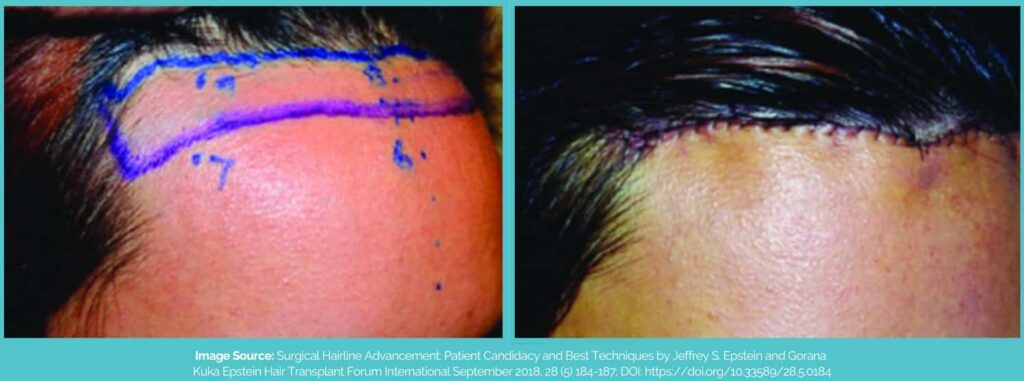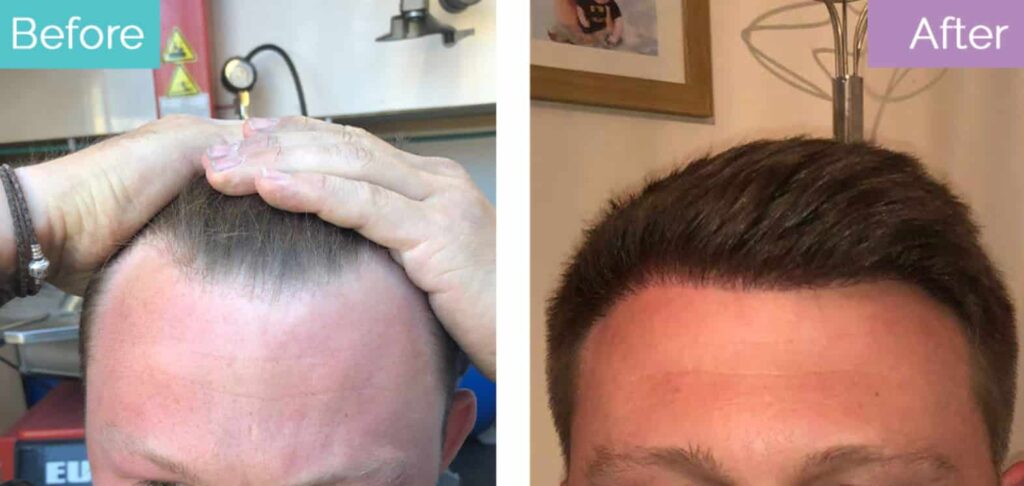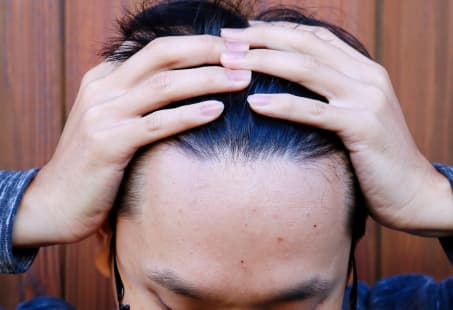“Hairline lowering” is an umbrella term for procedures that aim to reduce the size of the forehead and bring the hairline forward. Essentially, a hairline lowering surgery can refer to a surgical hairline advancement (SHA), also simply known as a forehead reduction, and/or a traditional hair transplant surgery.
While you can have both surgeries to lower your hairline, each surgery, on its own, has certain limitations. However, there are instances in which your surgeon might recommend both surgeries (not at the same time) to help you achieve the best possible results. In this guide, you’ll learn more about which procedure might be more suitable for you.
How Does Hairline Lowering Surgery Work?
A hairline lowering surgery can work in one of two ways:
Forehead Reduction
Surgical hairline advancement or forehead reduction is a type of plastic surgery in which a piece of skin is removed from the forehead to lower the hairline.

According to a study published in Facial Plastic Surgery Clinics of North America, the hairline can be lowered by as much as 2-5 centimetres, which is equivalent to 7,000 to 9,000 hair grafts in a transplant. Although usually 2 cm is the average, your surgeon should discuss this with you in advance.
One important consideration when determining how much a hairline can be lowered is the mobility of the scalp. This is the deciding factor on how low the hairline can go. Of course, not all patients have a rather mobile scalp.
In this case, another research published in Hair Transplant Forum International suggests the use of a balloon tissue expander to stretch the skin out over a period of 4-6 weeks. But it’s more demanding on the patient and can affect the aesthetics of the hair (as hair follicles can move apart due to the stretching).
Another important thing that doctors need to take into consideration before recommending this surgery is the stability of your hairline. Since this surgery leaves a scar along the hairline, if you have androgenetic alopecia, you won’t be suitable for a forehead reduction.
Once the hairline starts to recede, your surgical scar will be exposed and even a hair transplant might not be able to help you because there might not be enough hair grafts in the donor area.
Since hairline recession is more common among men (it’s rare in women), gender has to be accounted for during patient selection. Hairline lowering surgery for males might not be suitable a lot of the time.
Hair Transplant
Hairline lowering with transplantation surgery is also possible through the implantation of hair grafts. For this, the surgeon can use any of the following techniques:
In FUE, a punch tool is used to extract hair grafts from the back and/or sides of the scalp. These are then placed into the balding areas via small incisions.


On the other hand is the FUT technique in which a piece is skin is first cut out from the scalp. The individual hair grafts are cut out from that then (so a punch tool is not used).
This technique requires stitches and can leave a long, linear scar on the back as well, which is why the FUE method is preferred. Of course, compared to a forehead reduction, this surgery is less invasive.
How Is Hairline Lowering Surgery Done?
The technique for hairline lowering will depend on which surgery you’re undergoing.
- Forehead reduction – Your surgeon will assess your scalp and mark the area to which your hairline will be lowered. Usually, general anaesthesia is given, after which the extra skin between the old and the new hairline is removed. A gradual tension is applied to the scalp to move it forward. Once everything’s done, the skin will be stitched back up (near the hairline), and your head will be bandaged.
- Hair transplant – For this, the balding and donor areas are assessed and the new hairline is drawn, after which your head may or may not be shaven. This surgery takes place under local anaesthesia, where grafts are scored out from the back and placed into the bald spots through small incisions. It’s outpatient, so you can return to your home/hotel with bandages on the donor areas.
It’s not unusual for surgeons to recommend both forehead reduction and hair transplant to patients. The latter can help round the hairline after a forehead reduction.
Other than that, a hair transplant can also help hide the forehead reduction scar through graft placement. It can also lower your hairline a little more. But you’ll have to wait for 3-4 months after your first surgery to get the second one.
How Painful Is Hairline Lowering Surgery?
Hairline lowering surgery should not cause any pain because both forehead reduction and hair transplant take place under anaesthesia.
Typically, it’s general for the former and local for the latter, meaning you’ll be asleep during forehead reduction but awake during hair transplant.
After the surgery, however, you can experience pain during the recovery. Your surgeon might prescribe you painkillers for these. Make sure to consult them about it.
How Long Is Recovery For Hairline Lowering?
In the case of both forehead reduction and hair transplant for hairline lowering, the downtime is less than a week.
You might be okay to resume your normal activities 2-7 days after the reduction surgery, although you’ll have stitches in for at least 1 week, and you can also experience side effects like:
- Swelling
- Bruising
- Redness
- Pain
- Numbness
You’ll likely be given an ointment so that the incision sites are well-moisturised. And your doctor might advise you to avoid strenuous activities for about a week or more. In a month or so, hair should start to grow out in the surgical areas, but you can immediately see the results of the surgery.

For a hairline lowering transplant surgery, the downtime is around 2-3 days, and this can also cause side effects like swelling, itchiness, folliculitis, pain, etc.
You might experience a temporary shock hair loss, but your hair should start to grow after 3 months, although you’ll have to wait for about 12 months to see the final results.
Does Hairline Lowering Surgery Leave A Scar?
Scarring is a risk of both forehead reduction and hair transplant surgery for lowering the hairline. However, done by an experienced surgeon, your scars should not be visible.
In forehead reduction, the scar will be red at first, but it should settle down with time. If it’s still visible, a hair transplant can always help hide it (provided you have enough grafts in the donor area).
With a hair transplant, if you’re getting FUE, the size of the incisions will be so small that they won’t be visible after the hair grows out. After a FUT hair transplant, the linear scar can also be hidden by longer hair, but with short hair, it can be clearly seen.
How Much Does Hairline Lowering Surgery Cost In The UK?
In the UK, hairline lowering through forehead reduction can cost you anywhere from £5,000 to £10,000. A hair, on the other hand, can cost you £4,000 or more. Normally, each graft is around £4-£5. If you’re undergoing both, the total cost can be £15,000+.
Of course, the hairline lowering surgery cost can vary depending on its complexity (like the use of a tissue expander), the experience of the surgeon and the location of the clinic.
Some clinics may offer flexible payment plans so that you can pay for the treatment in instalments since the hairline lowering surgery price can be quite high.
How Much Does Hairline Lowering Surgery Cost In Turkey?
A hairline lowering surgery cost in Turkey with just forehead reduction might be somewhere between £2,000 and £3,000. A hair transplant is around £1,500-£2,000. It is generally cheaper because of currency exchange and the low cost of living in the country.
Many clinics don’t charge by the number of grafts and also include hotels and transfers in the treatment plan along with the surgery and anaesthesia. So even for both procedures, hairline lowering surgery in Turkey might cost you under £5,000.
Is Hairline Lowering Surgery Safe?
Hairline lowering surgery is generally considered safe as long as you choose an experienced and board-certified provider. Even so, the hairline lowering does carry certain risks.
A few risks of forehead reduction include scarring, hair loss, infection, asymmetry, etc. Hair transplants can also cause scarring, infection, pain, and bleeding, among other things. It’s important that you discuss these with your surgeon beforehand.
Both forehead reduction and hair transplant are technique-sensitive, and if your surgeon doesn’t know what they’re doing (and/or chooses the wrong patient), the results can be quite poor.
There have been cases of hairline lowering surgery gone wrong, such as improper wound closure could put tension on the incision site, which can lead to a widened scar. It can also be accompanied by permanent hair loss, so you need to be careful about your choice of clinic.
Forehead Reduction vs Hair Transplant: What Are The Differences?
One of the main differences between a forehead reduction and a hair transplant is that the former is plastic surgery while the latter is a hair transplant.
So, even though the end goal is intended to be the same, the techniques are completely different. Here’s a summary of the differences between the two procedures.
| Forehead Reduction | Hair Transplant | |
| Procedure | A piece of skin is cut out from the forehead and the hairline is pulled forward and downward. | Hair grafts are taken out from the back and/or sides of the scalp and implanted into the bald spots |
| Candidates | Usually, this hairline lowering surgery is for females with a naturally large forehead or that’s become taller due to a condition like frontal fibrosing alopecia (after the condition has stabilised). Older men with stable hairlines can also undergo it. | For both men and women who have sufficient hair in the donor area. Can also be done after forehead reduction to make the hairline round, further lower it, and/or hide its scar. |
| Anaesthesia | Usually general but can also be local | Local |
| Surgery time | 2-3 hours | 6-8 hours |
| Downtime | 2-7 days | 2-3 days |
| Risks | Infection, scarring, asymmetry, hair loss, bleeding, etc. (consult your doctor) | Infection, scarring, bleeding, pain, etc. (consult your doctor) |
| Cost | UK: £5,000 to £10,000 Turkey: £2,000 to £3,000 | UK: £4,000 to £30,000 Turkey: £1,500 to £2,000 |
| Results | Immediate and permanent | Seen after 12-18 months but permanent |
How To Lower Hairline Without Surgery?
Since you can’t physically move the forehead or the hairline without surgery, it’s not possible to lower it without surgical intervention.
You can consider wearing a toupee instead or even trying out bangs to make the forehead look smaller. Scalp micropigmentation might also work if you have a buzzcut.
Conclusion
Hairline lowering surgery is a cosmetic procedure that can very effectively reduce the height of the forehead and create facial harmony (rule of thirds). There are two ways in which you can get this done: forehead reduction and/or hair transplant.
The hairline lowering surgery for men that’s usually considered more suitable is a hair transplant because of the potential for future hair loss. Women can undergo both since they’re more likely to have a stable hairline.
In any case, however, you must do your research when looking for a surgeon for these procedures. Done wrong, they can cause a lot of problems for you. Make sure to find someone experienced, ask all the questions, and check their portfolio.
Reviewed and Approved by Trichologist Yaprak Yazan
